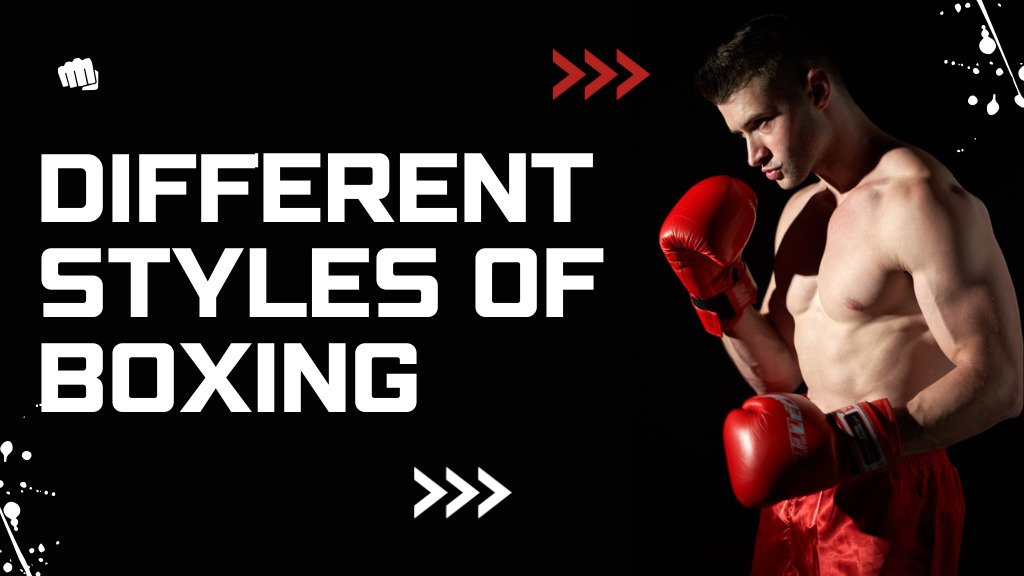Boxing is a captivating sport that has evolved over centuries, with fighters developing various styles and techniques to excel in the ring. Each style brings its unique characteristics and strategies, adding to the complexity and excitement of the sport. In this article, we will explore the different styles of boxing, from the traditional to the modern, and even some unconventional approaches.
The Importance of Boxing Styles

Delving into the importance of boxing styles reveals that they are not just a repertoire of techniques; rather, they serve as the very foundation of a boxer’s approach to the sport. Your chosen boxing style becomes a defining aspect of your strategy when you step into the ring. It plays a pivotal role in how you approach your opponent, defend yourself, and ultimately aim to secure victory.
Each boxing style has its unique characteristics and strengths. By understanding and mastering a specific style, a boxer can harness these attributes to their advantage. Let’s explore this in more detail:
- Strategic Advantage: Boxing styles provide a strategic advantage. Whether you opt for the classic finesse of outboxing or the relentless pressure of brawling, your style dictates your approach to a fight. This choice can catch your opponent off guard or force them to adapt to your game plan.
- Leveraging Strengths: Your boxing style aligns with your inherent strengths. If you possess excellent footwork and agility, classic boxing might be your best choice. Conversely, if you’re known for your power and aggressiveness, brawling could be your forte. Your style accentuates your natural abilities.
- Exploiting Weaknesses: Understanding your own style also means recognizing your weaknesses. Effective training and preparation can help you mitigate these weaknesses, ensuring that they don’t become liabilities in the ring. Your chosen style should minimize vulnerabilities.
- Psychological Edge: Your style can also influence the mental aspect of the sport. A boxer with a distinctive style can establish a psychological edge over opponents. They may be less predictable, leaving their challengers uncertain of what to expect.
- Adaptability: While mastering a particular style is crucial, adaptability is also key. Being able to switch tactics when necessary can keep opponents guessing and open up new opportunities for success.
Traditional Boxing Styles
Let’s take a closer look at traditional boxing styles, which encompass a rich history of pugilistic techniques:
Classic Boxing
Classic boxing, epitomized by iconic fighters like Muhammad Ali, is a style that places a premium on finesse, footwork, and precision jabs. Boxers adopting this style aim to control the ring, outsmart their opponents with superior skill, and utilize their speed to gain the upper hand. It’s often characterized by graceful movement and strategic decision-making.
Brawling and Swarming
Brawling and swarming, in contrast to classic boxing, are marked by relentless aggression and a focus on overwhelming opponents with constant pressure. Legendary brawlers such as Mike Tyson are celebrated for their ferocity and knockout power. Fighters who embrace this style seek to close the distance quickly, engage in close-quarters combat, and utilize power punches to subdue their adversaries. Brawling and swarming are known for their intensity and the potential to end fights decisively and swiftly.
Modern Boxing Styles
Exploring modern boxing styles, we encounter two distinct approaches that have gained prominence in contemporary ring warfare:
Counter-Punching
Counter-punching is a craft mastered by tacticians who possess an exceptional ability to read their opponent’s moves like an open book. These fighters are known for their patience and composure. They don’t rush into exchanges; instead, they wait for their opponent to make a move. Once their adversary commits to a strike, the counter-puncher strikes back with precision and perfect timing. This style is akin to a strategic game of chess, where every move is calculated, and openings are exploited with razor-sharp accuracy. Counter-punchers aim to turn their opponent’s aggression against them, often leaving their foes frustrated and off-balance.Out-Boxing
Out-boxers, in contrast, embrace the art of maintaining distance and controlling the ebb and flow of the fight. They are the ring’s conductors, orchestrating the pace and tempo. Utilizing their reach, agility, and sharp sense of strategy, out-boxers keep their opponents at bay. This style is all about staying on the outside, frustrating opponents with swift footwork and expert jabs. Out-boxers focus on scoring points through clean, long-range shots while avoiding unnecessary engagement. They are akin to matadors, guiding their opponents where they want them to go, all while avoiding the horns.
Unconventional Boxing Styles
Unconventional boxing styles introduce a level of unpredictability and adaptability that can confound opponents. Here are two distinctive unorthodox approaches:
Southpaw Stance
A southpaw boxer, often referred to as a “lefty,” is a fighter who adopts a stance with their right hand and right foot forward, which contrasts with the orthodox stance where the left hand and left foot are in front. This fundamental difference can be disorienting for opponents accustomed to facing orthodox fighters. Southpaws offer a different angle of attack and unique strategies. They often have a significant advantage in exploiting their opponents’ blind spots and vulnerabilities due to the unusual angle of their punches. Southpaw boxers can make it challenging for their rivals to predict and counter their movements, making them formidable adversaries in the ring.Switch-Hitting
Switch-hitters are the shape-shifters of the boxing world. They possess the remarkable ability to seamlessly transition between the orthodox and southpaw stances during a fight. This versatility keeps their opponents perpetually guessing, as they are unsure of which stance their adversary will adopt next. Switch-hitters leverage this ambiguity to create opportunities, launch unexpected attacks, and keep their opponents off balance. This style’s unpredictability is a tactical advantage, as it allows fighters to exploit their opponent’s weaknesses more effectively.The Evolution of Hybrid Styles
The evolution of hybrid styles in boxing has given rise to a new breed of fighters who seamlessly blend the best of multiple worlds. Two such hybrid styles that have gained prominence are:Boxer-Puncher
Boxer-punchers are a versatile and adaptable breed of fighters. They seamlessly merge the finesse and strategic prowess of outboxing with the raw power and aggression of brawling. These fighters can expertly switch between controlling the distance and engaging in close-quarters combat, making them adaptable in various situations in the ring. The boxer-puncher is characterized by their ability to read their opponent’s strengths and weaknesses and adjust their strategy accordingly. They can dictate the tempo of the fight and keep their opponents on edge, never quite sure of what’s coming next.Peek-a-Boo Style
The peek-a-boo style, popularized by the legendary Mike Tyson, is a compact and defensively-oriented approach. Fighters who adopt this style utilize a high guard to protect their head and upper body. They employ head movement, often bobbing and weaving, to slip and roll with their opponent’s punches. This defensive shell provides them with excellent protection while allowing them to stay close to their adversary. The peek-a-boo style is all about patience and waiting for the right moment to counter-attack with devastating power. It’s a style that requires exceptional reflexes and timing.
Training for Different Styles

Training is the crucible in which a boxer hones their skills, refine their chosen style, and prepare for the rigors of the ring. Let’s explore how boxers train rigorously to master their selected styles:
Sparring
Sparring is the heart of a boxer’s training regimen. It’s where theory meets practice. Boxers engage in controlled, simulated bouts with training partners, aiming to replicate real fight scenarios. Sparring allows fighters to apply their chosen style in a dynamic environment, adapt to different opponents, and develop their defensive and offensive strategies.Conditioning
Conditioning is a vital aspect of boxing training. It encompasses cardiovascular fitness, strength, and endurance. Different styles place varying demands on a boxer’s physical attributes. For example, brawlers need to focus on building power and explosiveness, while out-boxers may emphasize endurance and agility. Conditioning ensures that fighters have the stamina to execute their style effectively throughout a match.Strategy Development
Each boxing style requires a distinct game plan. Boxers work closely with their trainers to develop strategies tailored to their chosen style. This involves understanding when to attack when to defend, and how to exploit an opponent’s weaknesses. Strategy development is an ongoing process, evolving with experience and adaptation.Technical Drills
Boxers practice specific techniques and movements related to their chosen style through technical drills. For example, classic boxers work on perfecting their jabs and footwork, while brawlers focus on power-punching drills. These drills help in refining the finer details of a style and ingraining muscle memory.Sparring Partners
Boxers often seek sparring partners who replicate the style of their upcoming opponents. This provides a chance to fine-tune their approach and get accustomed to their adversary’s style.Mental Training
Mental fortitude is just as critical as physical prowess. Boxers undergo mental training to develop focus, discipline, and confidence. They learn to stay composed under pressure, adapt to changing circumstances, and make split-second decisions in the ring.Video Analysis
Studying both their performances and those of their opponents is a crucial part of training. Boxers analyze past fights to identify areas for improvement and to formulate strategies to exploit their rival’s weaknesses.
Conclusion
In conclusion, the world of boxing is rich and diverse, with a myriad of styles that continue to evolve. From classic boxing to modern and unconventional approaches, each style offers a unique path to victory. Understanding these styles is crucial for both aspiring boxers and avid fans of the sport.
FAQs
What is the most popular boxing style?
Popularity varies, but classic boxing is often a favorite.Are there female boxers with unique styles?
Yes, fighters like Clarisse Shields and Laila Ali have distinct styles.How do I choose the right boxing style?
Assess your strengths and preferences with a trainer’s help.
Related Post:




